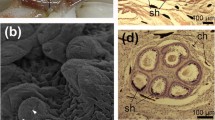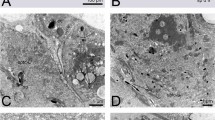Abstract
Previous investigations showed that in Arianta arbustorum incoming sperm are not equally distributed among all tubules of the sperm storage organ, the spermatheca, and it has been assumed that the sperm recipient might influence paternity after multiple mating. Understanding postmating sexual selection requires understanding the function of the genitalia. Against this background we analyse the ultrastructure of the spermathecal epithelium, give a brief description of the sperm morphology and describe the sperm–epithelium interactions. The epithelium of the spermatheca, which consists of up to nine blind tubules originating from a common duct, is a monolayer composed of a single cell type. Only the density of the ciliation increases along the tubules and the common duct. In addition, the cilia of the latter are more than 50% longer than those in the tubules. These long and densely arranged cilia not only prevent autosperm from getting into the spermatheca, but may also be responsible for sorting sperm in the spermatheca allowing the recipient to store sperm from different partners separately. The most peculiar characteristics of the epithelium are the wide intercellular spaces at the base continuing apically into narrow channels used for extracellular transport. Below apical junctions, the cells adhere to each other through interdigitations, which form an extensive labyrinth at the base and rest on the basement membrane. Rough endoplasmic reticulum and Golgi complexes are mainly found in the vicinity of the basally positioned nucleus. A large vacuole lies above the nucleus and the apical portion of the cytoplasm is densely populated with mitochondria. Vesicles of various sizes are also found mainly in the apical region. The spermatozoa stored in the hermaphrodite duct prior to transfer are characterised by an acrosome forming an angle of 90° with the longitudinal axis of the nucleus and vesicles of undefined shape in the terminal end of the flagellum. In the spermatheca the spermatozoa lose their perinuclear sheath and the acrosome is almost in line with the longitudinal axis of the sperm. This process is interpreted as capacitation. In the spermatheca, the capacitated spermatozoa are in close contact with the epithelial cells. However, an exchange of substances was not observed. It is assumed that the epithelium provides the environment for sperm quiescence rather than nutritives.
Similar content being viewed by others
Author information
Authors and Affiliations
Additional information
Accepted: 28 August 2000
Rights and permissions
About this article
Cite this article
Bojat, N., Sauder, U. & Haase, M. The spermathecal epithelium, sperm and their interactions in the hermaphroditic land snail Arianta arbustorum (Pulmonata, Stylommatophora). Zoomorphology 120, 149–157 (2001). https://doi.org/10.1007/s004350000031
Issue Date:
DOI: https://doi.org/10.1007/s004350000031




